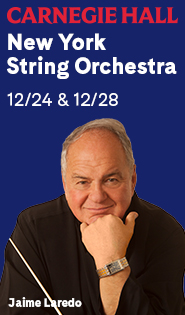Batiashvili and Brahms triumph in mixed Philharmonic program

Lisa Batiashvili performed the Brahms Violin Concerto with Alan Gilbert and the New York Philharmonic Thursday night.
The New York Philharmonic’s concert on Thursday was a bit of an oddity, as Alan Gilbert departed from the standard overture-concerto-intermission-symphony concert order by putting the concerto on the second half. This practice is not unheard of, and was a common trick of Leopold Stokowski, but the particular pairing on this concert’s first half was unsatisfying.
Thursday’s overture, of sorts, was a world premiere by Christopher Rouse, Thunderstuck (that’s not a typo). An hommage to Jay Ferguson’s 1978 hit Thunder Island, Rouse says the work is meant to be “engaging and fun.” It is both those things to some degree, though it is also completely out of left field, both in general and for Rouse specifically. Suave, punchy, and almost oppressively consonant, it sounds as though it could accompany a training montage in a boxing movie.
Rouse’s score calls for a trap set, which features prominently in the piece, banging out a figure somehow suggestive of both a rock beat and tribal drumming at once. Heavy brass and jagged rhythms, delivered with appropriate brashness by the Philharmonic, with occasional interludes of syrupy strings, strongly evoke the ’70s movie-rock aesthetic, though a lot of out-of-sync noodling tried to keep the piece “edgy.”
Thunderstuck was followed by Haydn’s “Drumroll” Symphony, No. 103,which left a good deal to be desired. On the whole the symphony was clean, clear, and uncomplicated. Gilbert’s phrasing felt artificial, creating an air of affected grace but stifling the music’s cheery character. The finale, defined by its forward thrust, felt motionless.
First-chair solos, notably from acting concertmaster Sheryl Staples at the end of the Andante and the paired horns of Richard Deane and R. Allen Spanjer at the opening of the Finale, were bright spots in the symphony. The audience did not do much to help, offering two cell phone rings and a malfunctioning hearing aid that whined through the entire first half of the program. In all, between the saccharine Rouse premiere and aloof Haydn, the first forty-five minutes made for a head-scratcher.
But, truth be told, to try to follow Lisa Batiashvili’s performance of the Brahms Violin Concerto with a major symphony after intermission would have been difficult. The Georgian virtuosa gave a searing rendition of the same concerto two seasons ago at Carnegie Hall with the Staatskapelle Dresden, showing that hers was a signifincant interpretation of this thrice-familiar piece.
Thursday’s performance was even more ferocious. Listening to Batiashvili, there is always a sense of security in her technique, a solid base on which to build an interpretation. That doesn’t mean she necessarily “makes it sound easy”—nor should she, in a concerto with such a broad emotional spectrum as this one.
The first movement illustrated that point perfectly, as she often dug heavily into the string to create a burning tone, with a side of gravel. Batiashvili is certainly capable of producing immaculate tone, as she demonstrated in this movement’s many lyrical passages, but often chooses not to—impurity of sound is just another weapon in the violinist’s arsenal, and few wield it better. Batiashvili gave a dark, searching account of Ferruccio Busoni’s cadenza, which makes heavy use of timpani for dramatic effect.
In the passionate Adagio, Batiashvili’s tone shimmered up high and then crackled as the line sloped downward. She employed uncommonly generous rubato, taking metrical and dynamic liberties that others would only dare attempt in a studio recording. The orchestra, meanwhile, lacked subtlety, the horns absolutely blaring over the cool oboe solo at the opening.
The finale was certainly “Allegro giocoso,” a stomping, grinning performance taken at a brisk pace; it may in fact have been “troppo vivace,” which Brahms’s marking specifically discourages, but who cares? Batiashvili’s playing was rugged, playful, blood-stirring all at once. She played firmly in the string for almost the entire movement, relenting only for the brief, singing quasi-cadenza right before the coda. This was a brilliant start to her yearlong residency with the Philharmonic. Her next program with the orchestra will include Samuel Barber’s gleaming Violin Concerto, sure to be an excellent fit for her emotionally expressive style.

